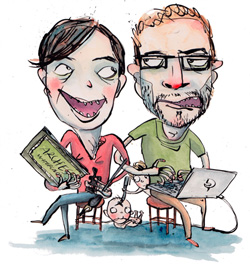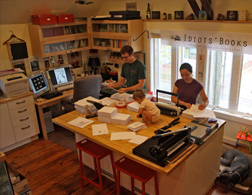Meet the Idiots
The creative pairs series so far: " Two Is the Magic Number" critiqued the lone-genius theory and introduced a new science of creative collaboration. " Two of Us" told the drama, in three acts, of the epic and often misunderstood Lennon/McCartney creative duel. Today, we have part one of the adventures of Matthew Swanson and Robbi Behr of " Idiots'Books," who've offered themselves as human guinea pigs (or, shall we say, crash-test dummies?) to sample methods that might shed light on collaboration, relationships, and creativity.
To continue the conversation, please comment below, tweet #creativepairs, or join the Creative Pairs Facebook page.
Is grave conflict inevitable in creative pairs? Will the very flames that heat fiery exchanges always cause third-degree burns, too?
It sure is common. Gilbert and Sullivan came to loathe each other. Pete Townshend once smashed his guitar over Roger Daltrey's head—and Daltrey hauled off and knocked Townshend unconscious. Even that rock 'n' roll tantrum (which makes John Lennon and Paul McCartney look like choirboys) falls far short of the violent extremes: After Oliver Cowdery, the Mormon Church's "second elder," challenged prophet Joseph Smith on points of doctrine, Smith's spokesman gave a sermon declaring that dissidents like Cowdery "be cast out, and to be trodden under foot of men."
But what about the pairs who seem to have all the rousing nights without any hangovers? Despite the comic rancor of their alter egos (Ernie and Bert; Kermit and Miss Piggy), Jim Henson and Frank Oz apparently worked together with ease and generosity. John Cage and Merce Cunningham made music and dance together, and loved one another, with a serenity that comes across in their joint interviews as a kind of deep meditation.
This harmony is all the more amazing when pairs seem to dive into a fully shared identity. The artists Gilbert Proesch and George Passmore—"Gilbert and George"—rarely appear in public without the other and nearly always wear matching suits. Wilbur Wright said that, from the time he and his brother Orville were children, they lived, played, worked together—"and, in fact, thought together."
Given all the landmines that creative pairs can stumble over—all the raging egos, all the resentments—what kind of Teflon suits protect the creative pairs that survive? Given all the fights over credit and money and power, how do some pairs share everything and love it? Is there a secret to a deep, abiding alliance? Or is there furious movement in these pairs, too—only, like the wings of a hummingbird, is it something you need to watch very carefully to see?
To study this question, I turned to my friends Matthew Swanson and Robbi Behr. They're the most entwined pair I know well. Their relationship almost feels like a fairy tale of creative partnership. They're married, have two kids, and live in a converted barn on the Eastern Shore of Maryland. He's a writer, she's an illustrator, and they make odd, excellent work together: dreamy, violent, funny marriages (and collisions) of words and pictures. They call their operation "Idiots'Books"—a declaration of their intent to do utterly foolish or senseless work that, to them, makes all the sense in the world.
It's hard to classify the Idiots' work—which is part of the point. They take pleasure in puzzling their readers and inviting them into the puzzle. The stories read like odd parables (as with Man Joe Rises); or bizarre, deadpan satirical riffs (as with The Baby Is Disappointing); or emotionally rich but narratively murky journeys (as with the Death of Henry).
Their books aren't children's literature ("Not unless the children are seriously maladjusted," Robbi says), nor graphic narrative ("If we tell a story with one of our books, it's kind of accidental," Matthew says), nor comics. Often, they're not books at all—like their "One-Page Wonders" series for Tor.com, single sheets of paper that each can be folded into 10 different shapes and form 10 full stories. They also brought the scissors to their book Ten Thousand Stories, where both the text and the images are snipped into four strips. Any combination of pages tells a complete story. (Thanks to a collaboration between the Idiots and Malloc Media, you can play with Ten Thousand Storiesonline.)
If there's one thing that defines Robbi and Matthew's work, it's the collaborative method itself—the long, creative tumble that they take together, like kids going downhill in a tire. Matthew says that his work doesn't even exist until he and Robbi talk about it and make it into something together. The collaboration extends well beyond their work, to encompass their very identities. "I know it sounds totally lame," Robbi says, "but Matthew really is the other half. He's half of what makes me."
To explore their connection, the Idiots agreed to undertake a series of stunts, experiments, and gambits—to act, in other words, like human guinea pigs for the series. Do you have a test to throw at Matthew and Robbi? Give us your suggestions here. You never know what these guys will try: They're as curious as anyone about how they work so well together, and what it all means.
I should note, of course, that this isn't a typical profile. I'm close to Matthew and Robbi, admire their work, and often dress my son in a onesie they created which I've described on Facebook as the Best. Ever.
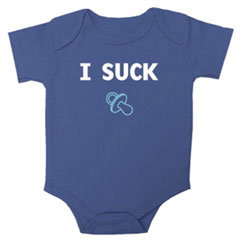
At the same time, Matthew and Robbi pledged at the outset that they'd reveal themselves as fully as their conscious minds allowed, and give me final say on what I included in this series. They've kept that promise.
Gambit: #1: The Idiots in the Lab
The recent explosion of relationship science has left no shortage of scientific papers to digest and popular books to browse—from Tara Parker-Pope's survey For Better: The Science Of a Good Marriage to Alex Pentland's treatise on nonverbal communication Honest Signals: How They Shape Our World. It's a hot field, with a lot of hot minds.
So it made perfect sense to bring the Idiots into the lab for a round of tests. We started with a foundational question: Are they really as enmeshed as they appear? It turns out there are actually ways to measure closeness, thanks to psychologists Arthur and Elaine Aron's work in the Interpersonal Relationships Lab at SUNY Stony Brook. Art Aron and his graduate student Suzanne Riela started the Idiots with the IOSS ("Including Other in the Self Scale"). "Please circle the picture below," it instructs, "that best describes your relationship with your partner."
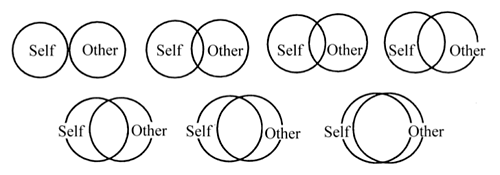
Robbi drew her answer.
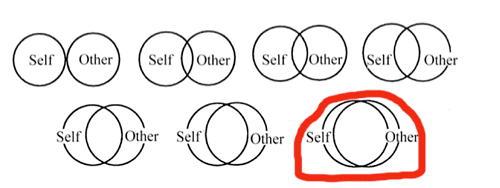
Matthew chose the same image. "I'd probably choose one where the two circles were even more on top of one another if there was one," he added for emphasis, "with just the faintest sliver of independent self visible outside the middle ground."
The IOSS scale is striking, especially since the average answer (with subjects describing the closest relationship in their life) is the fifth set of circles, which show a roughly similar space for the "self" and the shared space.
But a second test goes deeper than just a conscious identity statement, showing how, on basic levels of cognition, our idea of "self" can blur with close others. It's called the "Me/Not Me" test. You start by ranking to what degree 90 adjectives (like emotional and tactless and versatile) apply to you, and which ones apply to your close other. Then you sit at a computer screen, which flashes those same attribute words. The task is to press "yes" or "no" as quickly as possible, depending on whether the attribute fits you.
The key to the experiment, Aron explains, is the precise time lag from when the adjective appears on screen and the subject hits the key. It turns out that when people see attributes that are true of them but false of their close other—or false of them and true of their close other—there is a measurable delay in their response. "If I try to think of an aspect of myself—and my partner's not the same—it mixes me up," Aron explains, "because on some level we're the same person." True enough: Where their attributes diverged, Matthew was about 260 milliseconds slower giving his answers—and Robbi about 175 milliseconds. Time lags in previous studies (which were conducted under different conditions) have ranged widely—from 60 milliseconds in one to 652 milliseconds in another. But the effect size, Riela explains, shows that the lag is statistically significant. Aron, whose whole career is devoted to the psychology of intimate pairs, says Matthew and Robbi easily rank in the top 5 percent in terms of closeness.
Another study, developed by psychologist James Pennebaker at the University of Texas, shows how this connectedness seeps into the Idiots' language. Pennebaker pioneered an analysis he calls "Language Style Matching," which works by breaking texts into function words, such as prepositions, pronouns, and conjunctions (as opposed to content words, like nouns and verbs). In studies of pairs ranging from Freud and Jung to Robert and Elizabeth Barrett Browning to Ted Hughes and Sylvia Plath, Pennebaker and his colleagues have showed that pairs literally begin to match each other's language when they are most closely entwined (whether blissfully or in rage).
When the Idiots supplied Pennebaker and his graduate student Molly Ireland with 12 years' of correspondence, it turned out that their language matched to an astonishing degree—even at the lowest points, they were well above average; and at the highest point, they were off the charts. "They're in league with the Brownings—and much better than Ted Hughes and Sylvia Plath," Pennebaker says.
But I was struck by an even more simple finding—that, over the course of their relationship, their use of the first-person singular dropped precipitously. * In the graph below, the y-axis indicates the frequency of word-use and the x-axis reflects nine chronological time periods in Matthew and Robbi's correspondence.
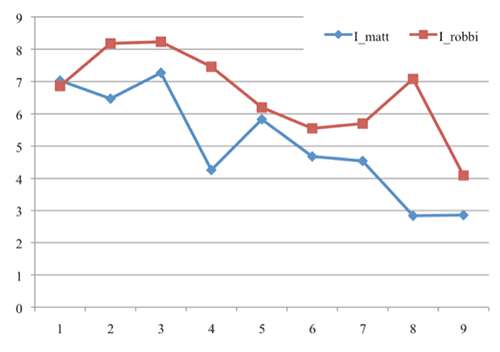
And their "we's" steadily climbed.
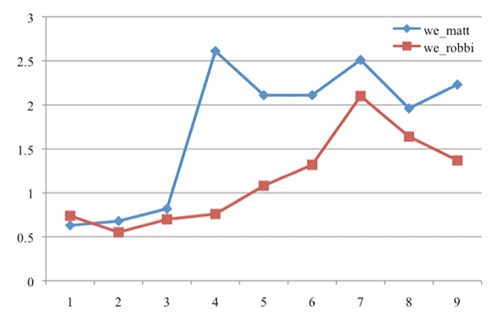
"The closer people are, the more they use we," Pennebaker says. "This is a phenomenon you can take to the bank."
But what's with the discrepancy—with Matthew's far greater use of we than Robbi, and his much less frequent use of I? This turned out to be a complex question. Saying I can be a declaration of autonomy and power—but it can also be a sign of deference and insecurity. Pennebaker and his colleagues have found that in situations with a power imbalance—a boss and a subordinate, say—the lower-status person will use more I's and the higher-status person more we's. Ironically, because the boss is more at ease, Pennebaker suggests, she can more easily focus on the other person.
The status hypothesis may or may not apply to the Idiots—but it is clear that their relationship is hardly without tension. That came through in a "Q-Sort" test devised by psychologist Vera John-Steiner specifically to assess creative pairs. Pairs are asked to rank 50 statements on a bell curve, from the truest to the least true.
For his top-ranked card, Matthew chose No. 31: "In a good collaborative environment, one's ideas can be made explicit through questioning and dialogue." Robbi chose card No. 35: "I expect my collaborator to be a critic of my work." They're clearly committed to having it out in their work. "We're not gentle with each other," Matthew says. Their whole art, they say, is a "quarrel between pictures and words."
Art Aron helps explain how closeness can felicitously coexist with tension. The reason we seek relationships in the first place, he says, is to get bigger—to get more resources to do more things, intellectually, emotionally, and practically. He finds out whether this applies to couples with the "Self-Expansion Questionnaire,"* which includes 15 questions like these:
"When you are with your partner, do you feel a greater awareness of things because of him or her?"
"How much do your partner's strengths as a person (skills, abilities, etc.) compensate for some of your own weaknesses as a person?"
Asked to rank their answers from one (not very much) to seven (very much)—Matthew scored a 6.86 and Robbi a 6.5. (Suzanne Riela's recent study found an average SEQ of 5.05 in romantic couples who'd been together for at least a year.)
This idea of getting closer, and bigger, might seem awfully romantic, but it also raises some basic questions. If one way we get bigger is by challenging each other (and if challenging can often mean irritating each other),how do we also stay attuned?
Then there's the shark problem. In Annie Hall, Annie suddenly turns to Alvy on an airplane and tells him she thinks they should break up. He agrees. "A relationship, I think, is like a shark. You know? It has to constantly move forward or it dies. And I think what we got on our hands is a dead shark."
This is essentially what Art Aron is saying. If people turn to a relationship for growth, that same relationship needs to keep growing—or else the very thing they turned to for more will suddenly seem like it's the epitome of less. But does that mean that a good relationship is also like an addiction—requiring ever-escalating doses? And if we need a relationship to expand the self—well, what is the "self," anyway?
It turns out, on this question, Robbi and Matthew are totally unsure. To dig into the space between them, I decided to get literal—and inspect their home and studio with a partner with the kind of training to suss out its secrets. Tune in tomorrow for Gambit No. 2: The Idiots in Their Barn.
Do you have a test, or experiment to throw at the Idiots? Comment below, or send an e-mail, or come onto the Creative Pairs Facebook page.
Correction, Sept. 28, 2010: This sentence originally misidentified the Self-Expansion Questionnaire as the Self-Expansion Quotient. (Return to the corrected sentence.)
Correction, Sept. 29, 2010: This article originally implied that "we" was not a first-person pronoun. (Return to the corrected sentence.)
